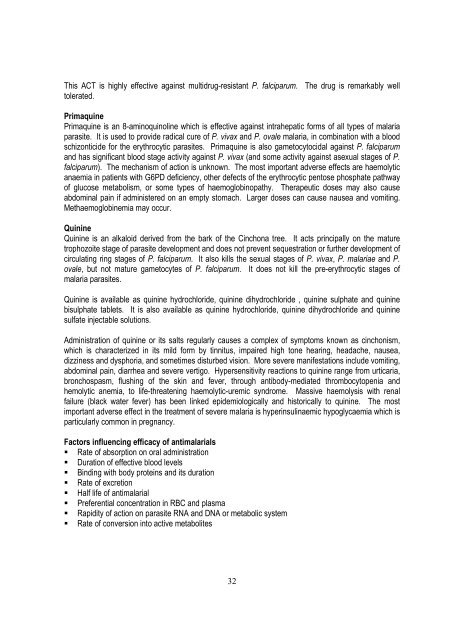training module for medical officers primary health centre - NVBDCP
training module for medical officers primary health centre - NVBDCP
training module for medical officers primary health centre - NVBDCP
- No tags were found...
You also want an ePaper? Increase the reach of your titles
YUMPU automatically turns print PDFs into web optimized ePapers that Google loves.
This ACT is highly effective against multidrug-resistant P. falciparum. The drug is remarkably welltolerated.PrimaquinePrimaquine is an 8-aminoquinoline which is effective against intrahepatic <strong>for</strong>ms of all types of malariaparasite. It is used to provide radical cure of P. vivax and P. ovale malaria, in combination with a bloodschizonticide <strong>for</strong> the erythrocytic parasites. Primaquine is also gametocytocidal against P. falciparumand has significant blood stage activity against P. vivax (and some activity against asexual stages of P.falciparum). The mechanism of action is unknown. The most important adverse effects are haemolyticanaemia in patients with G6PD deficiency, other defects of the erythrocytic pentose phosphate pathwayof glucose metabolism, or some types of haemoglobinopathy. Therapeutic doses may also causeabdominal pain if administered on an empty stomach. Larger doses can cause nausea and vomiting.Methaemoglobinemia may occur.QuinineQuinine is an alkaloid derived from the bark of the Cinchona tree. It acts principally on the maturetrophozoite stage of parasite development and does not prevent sequestration or further development ofcirculating ring stages of P. falciparum. It also kills the sexual stages of P. vivax, P. malariae and P.ovale, but not mature gametocytes of P. falciparum. It does not kill the pre-erythrocytic stages ofmalaria parasites.Quinine is available as quinine hydrochloride, quinine dihydrochloride , quinine sulphate and quininebisulphate tablets. It is also available as quinine hydrochloride, quinine dihydrochloride and quininesulfate injectable solutions.Administration of quinine or its salts regularly causes a complex of symptoms known as cinchonism,which is characterized in its mild <strong>for</strong>m by tinnitus, impaired high tone hearing, headache, nausea,dizziness and dysphoria, and sometimes disturbed vision. More severe manifestations include vomiting,abdominal pain, diarrhea and severe vertigo. Hypersensitivity reactions to quinine range from urticaria,bronchospasm, flushing of the skin and fever, through antibody-mediated thrombocytopenia andhemolytic anemia, to life-threatening haemolytic-uremic syndrome. Massive haemolysis with renalfailure (black water fever) has been linked epidemiologically and historically to quinine. The mostimportant adverse effect in the treatment of severe malaria is hyperinsulinaemic hypoglycaemia which isparticularly common in pregnancy.Factors influencing efficacy of antimalarials Rate of absorption on oral administration Duration of effective blood levels Binding with body proteins and its duration Rate of excretion Half life of antimalarial Preferential concentration in RBC and plasma Rapidity of action on parasite RNA and DNA or metabolic system Rate of conversion into active metabolites32
















